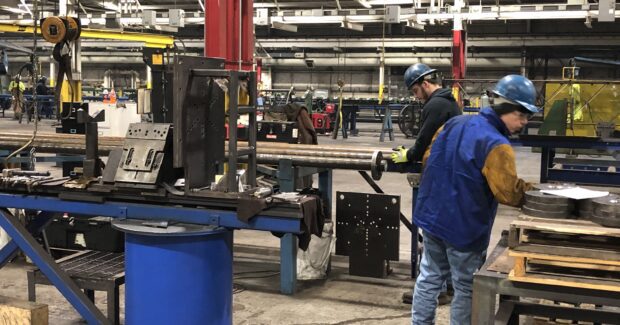Coming in Loud and Clear
This Kentucky communication tower fabricator got its start a century ago by maintaining water infrastructure assets. Now it’s cashing in on the market for telecommunications infrastructure.
Posted: January 20, 2020
Like many U.S. manufacturers, Pittsburg Tank & Tower Group is a family business that’s strategically morphed with the industries it serves. Founded in 1919 to maintain water tanks and smokestacks, the Henderson, Ky., company began manufacturing tanks in 1984. In 2003, it applied the operational expertise developed over two decades of fabricating ground and elevated storage tanks to fabricating steel broadcast and telecommunication towers.
Today, 115 Allstate Tower Inc. employees spread out over seven acres design, fabricate, install, maintain, inspect, and dismantle self-supporting towers, guyed towers, and monopoles as well as any accessory a customer may need: ladders, stairs, platforms, mounts, ice bridges, and ice shields. Of the 200 towers they make every year, about 5% are shipped overseas.
In 2018, Allstate Tower experienced a sales surge from the cellular, microwave transmission, railroad, utility, and energy markets and became a major supplier of modification and reinforcement materials. Sales were strong in 2019 and are expected to remain strong this year.
The company’s 20 American Welding Society-certified (AWS-D1.1) fitters/welders are as important to this ongoing success as the structural engineers who use tnxTower, SAP2000, and RISA-3D software to design the structure to Telecommunications Industry Association (TIA)-222 code based on their assessment of site location and terrain and loading requirements.
Design and Build Services
Allstate’s bread and butter are stock towers, called the 4015 and 5015 series, that come in 5-, 10-, and 20-foot sections that can be stacked up to 120 feet. However, the company also makes custom towers of any height.
Made from ASTM A36, A529 Grade 50, and A572 Grade 50 high-strength low-alloy (HSLA) carbon steel that withstands corrosion better than conventional carbon steel, a tower consists of three solid or tubular legs, each with an inner member, that are connected via cross-bracing fabricated on automated angle-processing machines made by Peddinghaus Corp. of Bradley, Ill. The company produced nearly 3,000 tons of structural steel in 2019.
Standard products go through the shop in a matter of days because components have been assembled and are stocked in inventory. More complex orders, such as 400-foot self-supporting tower for multiple cellular carriers, might take three weeks to fabricate.
The company also makes custom designs for difficult locations ranging in heights up to 500 feet as well as modification materials: split pipe; X-bracing; bridge stiffeners; U/V-bolts; clip-on waveguide ladders and internal/external climbing ladders; bolt-together or welded sections per the customer’s request; lighting packages; safety climb systems; lightning protection; air terminal solutions; down conductors, spline balls; brushes; and halos.
Allstate is an American Institute of Steel Construction (AISC) Certified Fabricator. Fitters and welders attach fabricated parts according to engineering specifications. They may lay out the components; lift, move, or hold them; or clamp workpieces to tables, into jigs, or into position. They also check assembled pieces for dimensional accuracy and correct quantity.
And they ensure Allstate continues to generate revenue after the tower is erected.
Allstate offers antenna and line maintenance, plumb and tension services, and tower and site grounding capabilities. After inspection crews assess the structure’s condition using laser range finders, center-of-radiation levels, transits, tension-meters, digital dynamometers, Radman RF detectors, and/or drones, welders fabricate and fit parts required to maintain or repair deficiencies. They’re also involved in dismantling and removing towers.
Anatomy of a Tower Build
All engineering, drafting, and manufacturing employees work under the same roof, which facilitates the entire manufacturing process. When a request for a quote comes in, the engineering group develops a design used to generate an estimate that goes to the potential customer. The design is reviewed again when the job is awarded to confirm accuracy.
The drafting team produces a set of fabrication drawings from the design, which usually takes about a week.
After that, one set of drawings is released to the purchasing department and another to the shop. Allstate closely monitors production scheduling to ensure the customer’s expectations are met. To streamline the process, stock inventory includes almost every size of round bar, the flanges that go on the end, and all the angle members that make up the braces. The purchasing department buys any raw materials that aren’t in stock.
Fabrication occurs in different parts of the shop. The Peddinghaus CNC machines process the angle members, solid round bar is cut to length, flanges are welded on the ends, and the leg pads are welded along the length of the legs (that’s what the bracing connects to). All other components – ladders, step bolts, and antenna mounts — are fabricated in different areas of the shop and sent to shipping.
Almost all — 95% — of these components are hot-dip galvanized. A truck takes components to a galvanizing facility in Nashville every day. When the truck returns, the components are sorted, staged together, and put with the tower.
Over the next week or two, everything is organized, assembled, and prepared for shipment. Bolts, nuts, safety climb devices, light kit, ground rods, lightning rods, etc., are pulled from inventory or purchased and staged with that job to be prepared for shipment.
“We strive to be the best part of any project we are involved in,” says Manufacturing Vice President Ray Fulkerson.
























